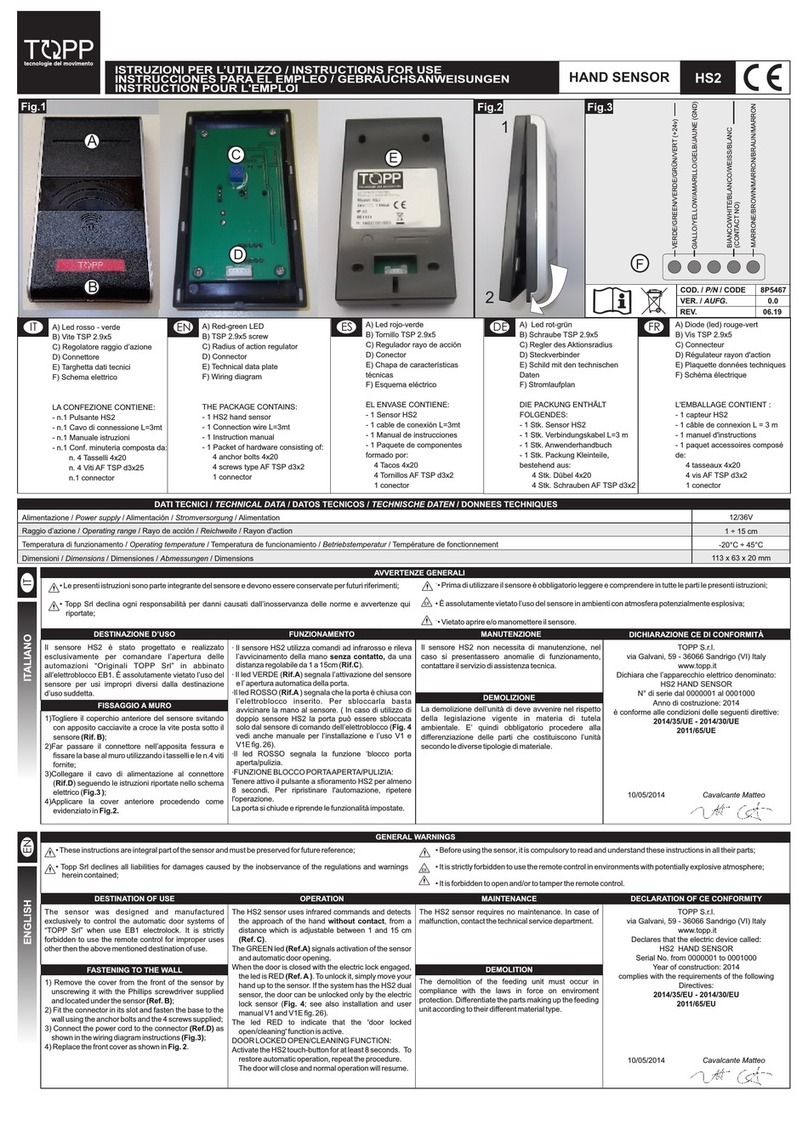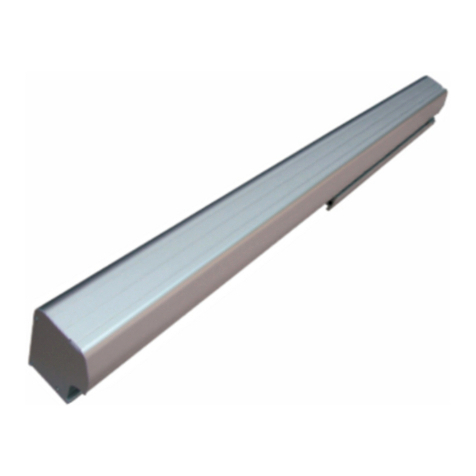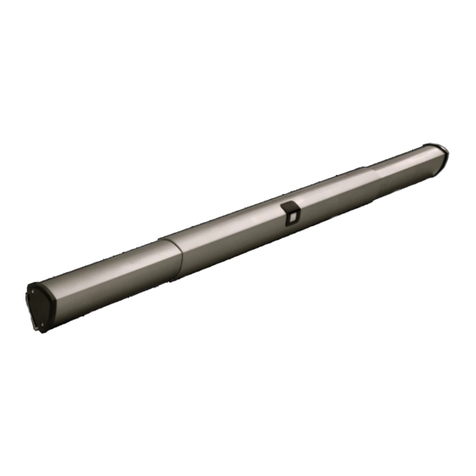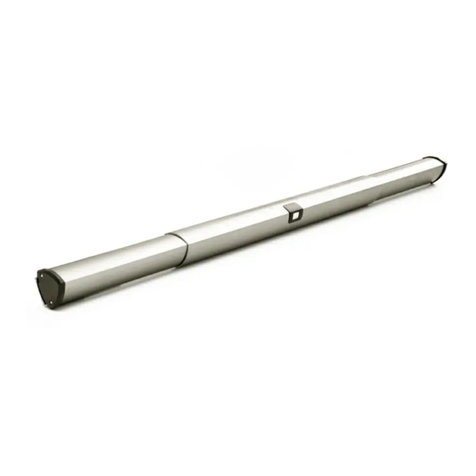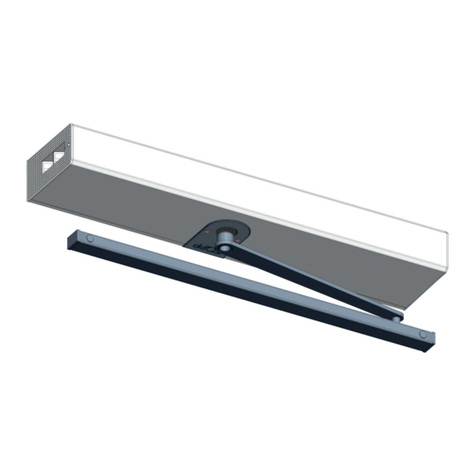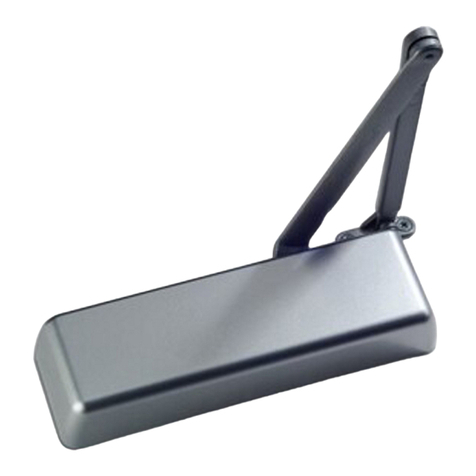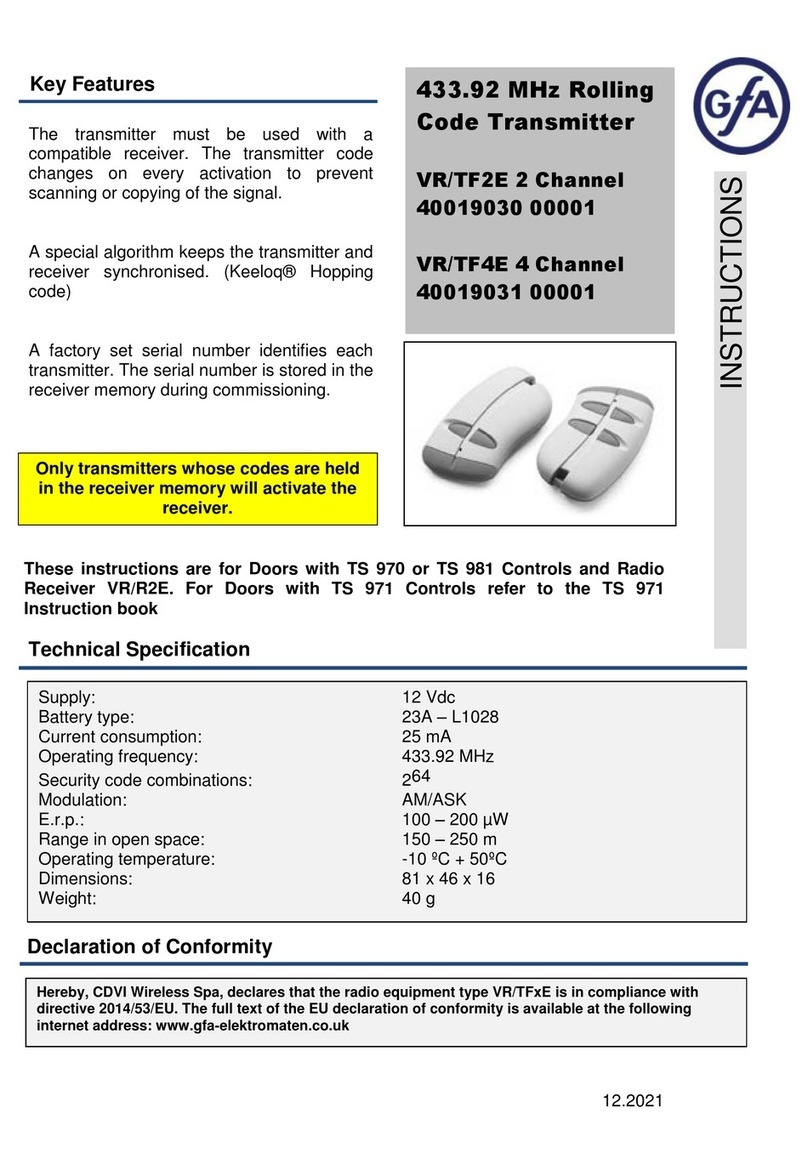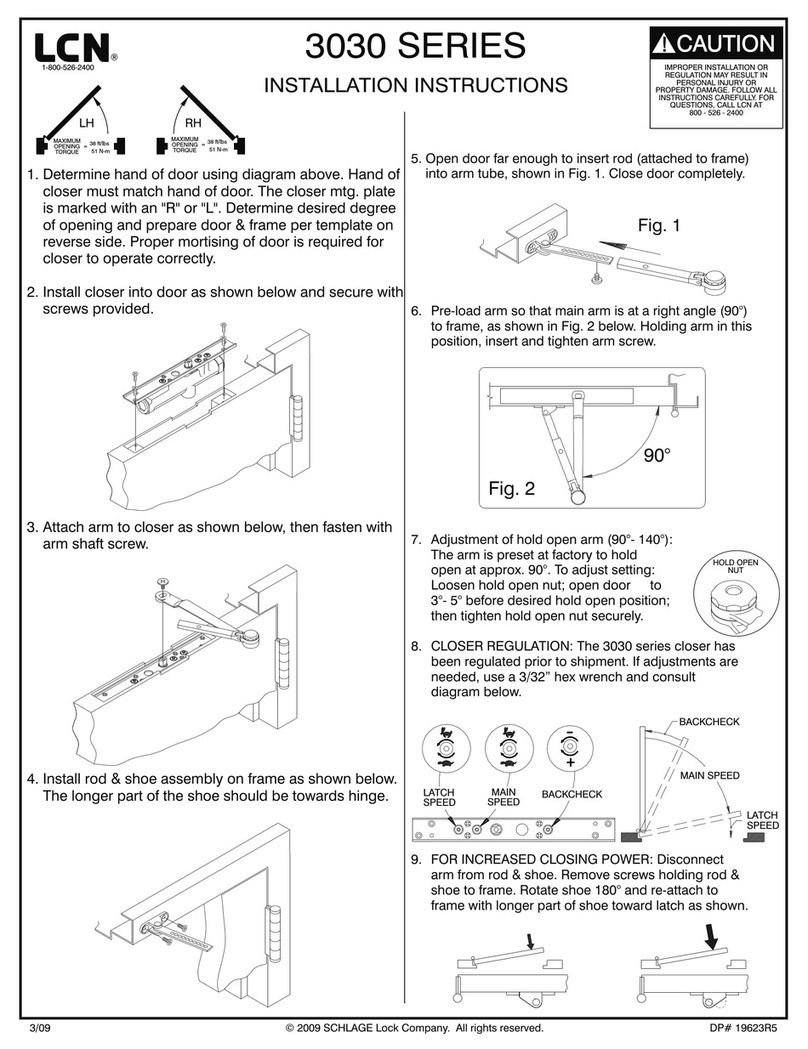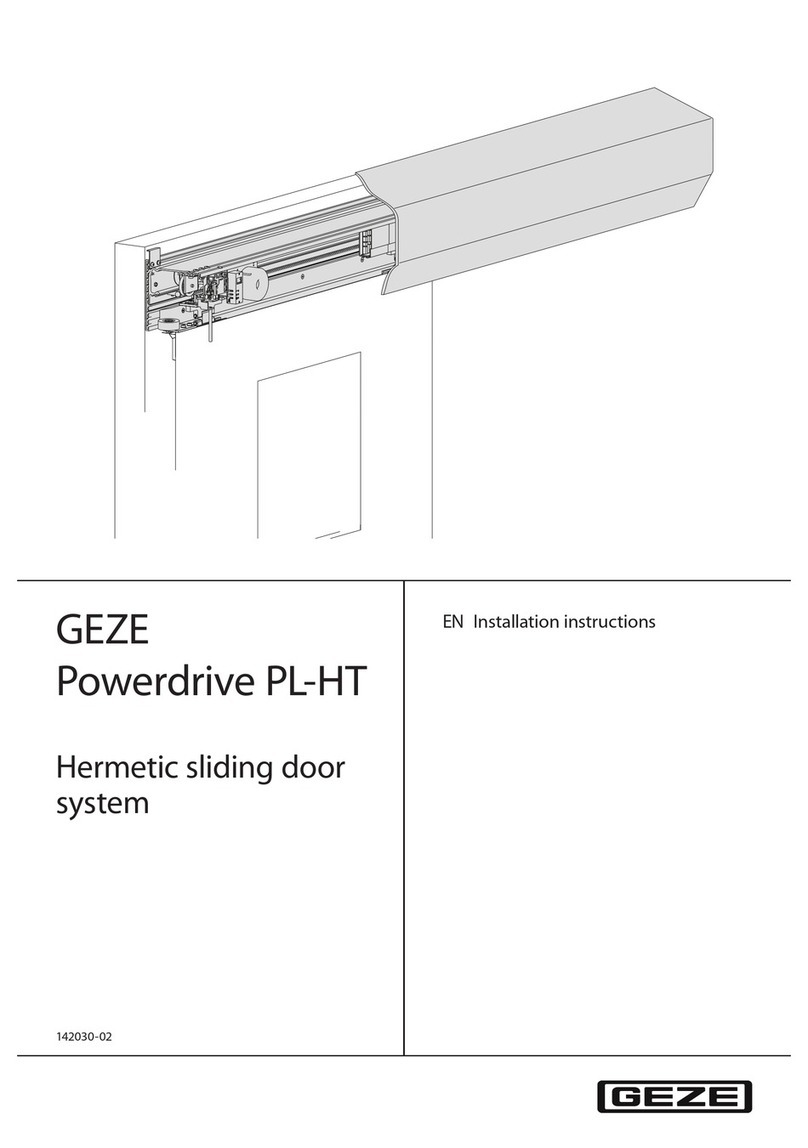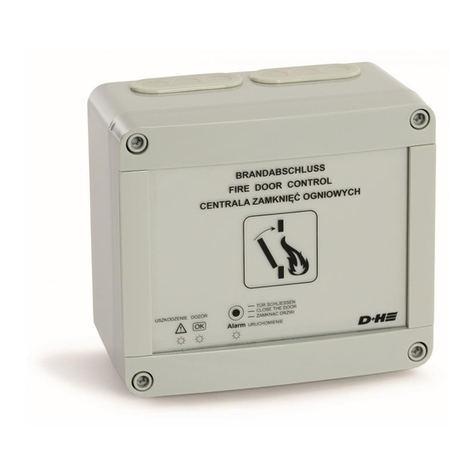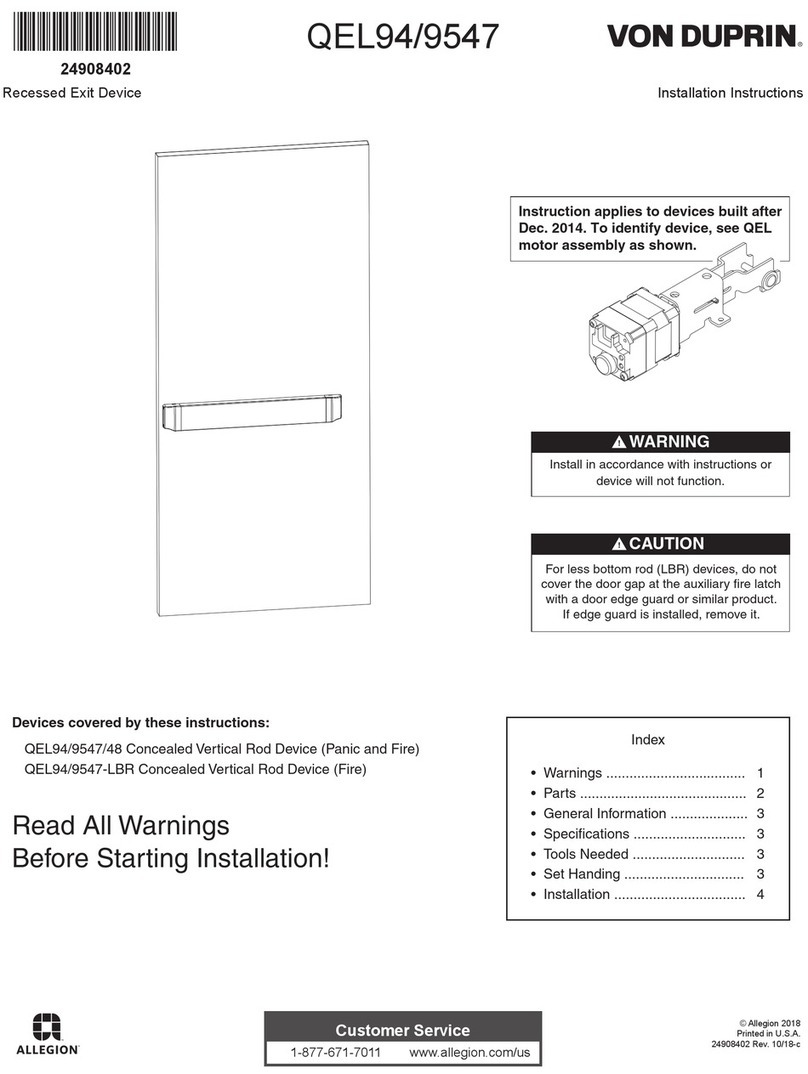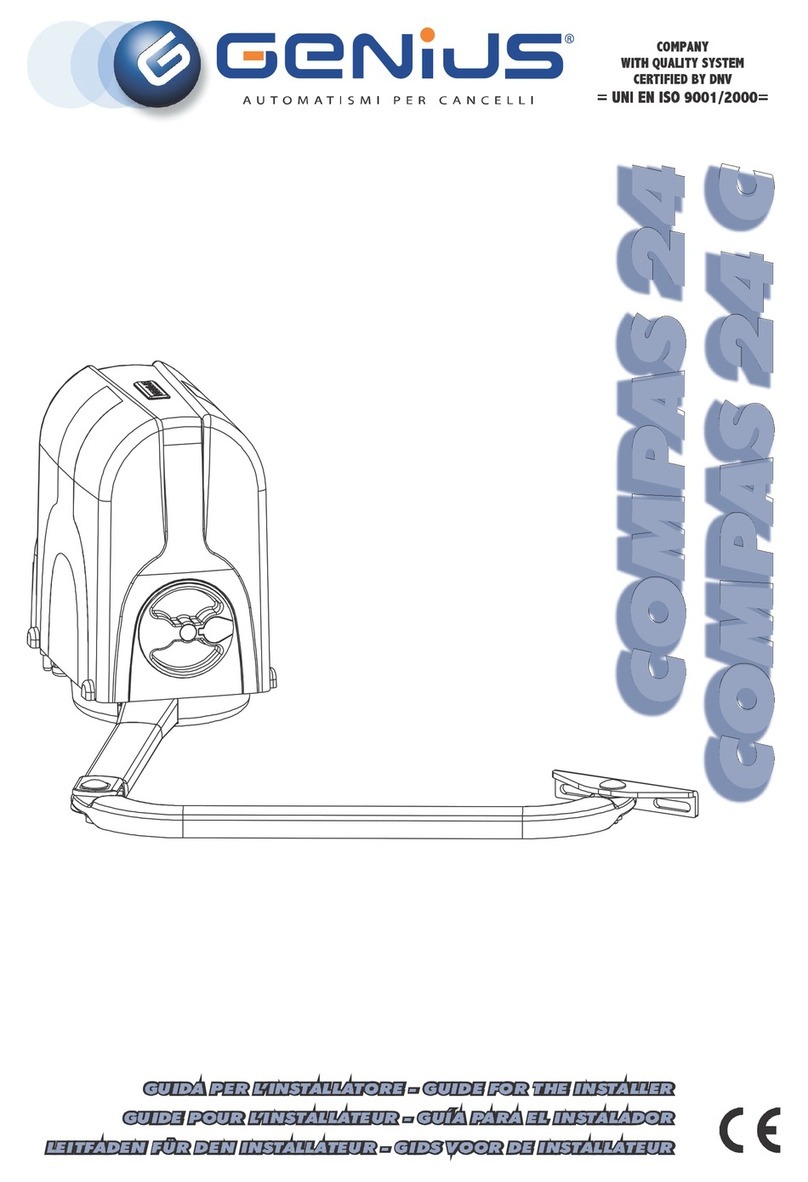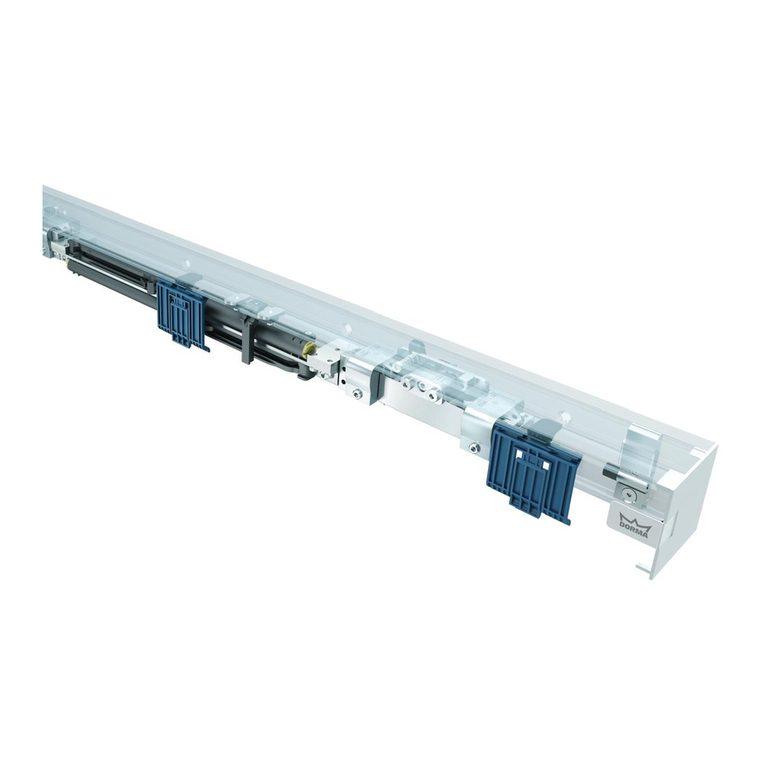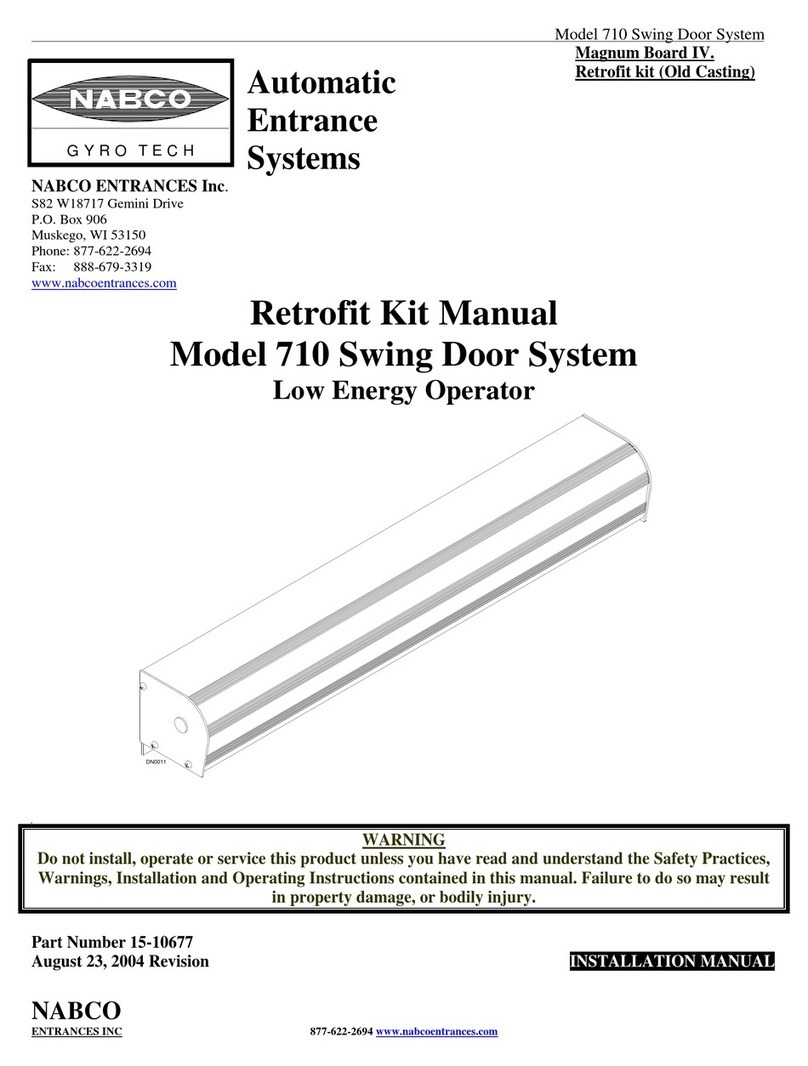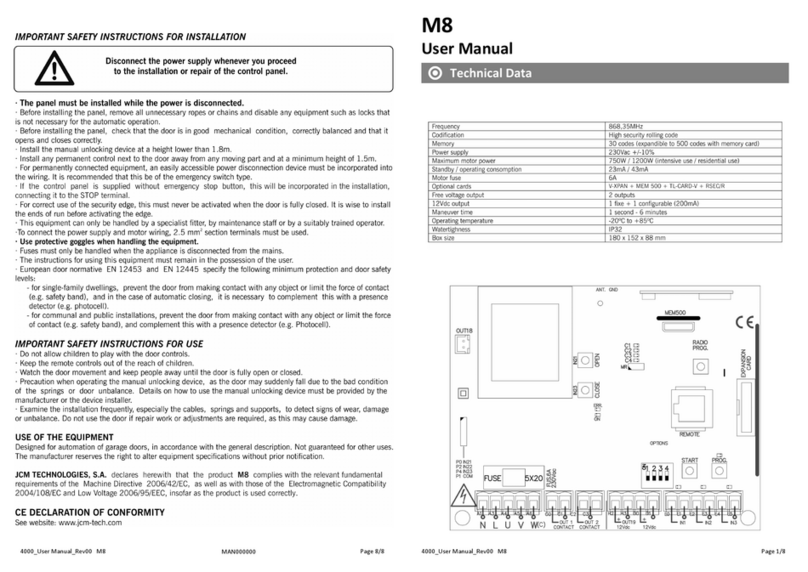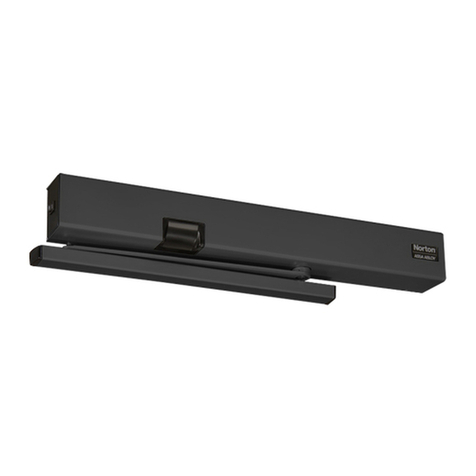TOPP K200T User manual

K200T
K280T
COD.0P5521
EN
VER 0.0
REV 08.19
INSTRUCTIONS FOR INSTALLATION AND USE
installer's manual/original instructions
LINEAR TELESCOPIC DOORS WITH TWO OR FOUR WINGS
ELECTROMECHANICAL AUTOMATION FOR SLIDING

IT
2K200T-K280T
EN INDEX
EN
INSTRUCTIONS FOR INSTALLATION AND USE
6.1- Maintenance ......................................................................................................................................pag. 58
5.10- Self restore management after anti panic alarm ..................................................................pag. 56
5.9- Self restore management of errors F-G-H-I-J .........................................................................pag. 56
7- EC DECLARATION OF INCORPORATION OF PARTLY COMPLETED MACHINERY ............................pag. 60
EU DECLARATION OF CONFORMITY ......................................................................................................pag. 60
5.4- Reset phase: learning .....................................................................................................................pag. 52
5.6- Programming parameters ...............................................................................................................pag. 53
5.8- Self restore management of errors C-D-E-K-N-P-Q ........................................................................pag. 55
5.5- restart in case of power failure:zero (near).......................................................................................pag. 52
5.11- self restore management after ........................pag. 56 opening fire or an opening of emergency
6.2- Spare parts and accessories available on request.............................................................................pag. 58
6- APPENDICES
6.3- Demolition...........................................................................................................................................pag. 59
5.12- Digital switch .................................................................................................................................pag. 57
5.7- List of errors and warning ................................................................................................................pag. 54
6.4- Troubleshooting ..................................................................................................................................pag. 59
1.5- Techinical assistance..........................................................................................................................pag. 04
3.7- Assembling drive bracket and belt block bracket on slow wing..........................................................pag. 18
4.3- Electronic control unit .........................................................................................................................pag. 29
2.3- Technical data ....................................................................................................................................pag. 05
3.6- Assembly and adjustment of fast and slow sliding wings ...................................................................pag. 16
4.2- Electrical connection...........................................................................................................................pag. 28
4.9- Connection of key device.................................................................................................................pag. 49
3.12- Assembling raceway fastening brackets for closure of the slow wing .............................................pag. 27
3.8- Assembling motor module, belt transmission,belt on fast wings and logline.....................................pag. 20
2.6- Types of sliding doors with two wings ................................................................................................pag. 07
3.9- Fastening drive brackets on fast wings .............................................................................................pag. 23
3.11- Assembling casing cover .................................................................................................................pag. 26
1- GENERAL INFORMATION
4- ELECTRICAL CONNECTION
2.1- Rating place and “CE” marking .........................................................................................................pag. 04
1.2- General safety rules ...........................................................................................................................pag. 03
3.2- Assembling the crossbar.....................................................................................................................pag. 11
1.1- General recommendations .................................................................................................................pag. 03
1.3- Installation...........................................................................................................................................pag. 03
1.4- User ....................................................................................................................................................pag. 04
2- TECHNICAL DESCRIPTION
2.2- Intended use ......................................................................................................................................pag. 04
2.5- Models................................................................................................................................................pag. 06
3- INSTALLATION
2.7- Description of parts and dimensions .................................................................................................pag. 08
3.1- General recommendations .................................................................................................................pag. 11
3.3- Assembling the adaptor and track ......................................................................................................pag. 12
2.4- Package..............................................................................................................................................pag. 05
3.5- Adjustment of trolleys and assembly of belt on slow wing..................................................................pag. 15
3.4- Assembling trolleys on wings .............................................................................................................pag. 13
3.10- Assembling wing block ....................................................................................................................pag. 25
4.1- General recommendations .................................................................................................................pag. 28
4.4- Pre-wired electrical connections.........................................................................................................pag. 30
4.5- Electrical wiring diagram (flow chart)..............................................................................................pag. 32
4.7- Program selection with MS1 knob ..............................................................................................pag. 48
4.8- DS2 digital connection ....................................................................................................................pag. 48
4.6- Connection of detection sensors ...................................................................................................pag. 33
4.10- Antipanic connection .....................................................................................................................pag. 49
4.11- Connetion of door block and pharmacy function .............................................................................pag. 50
5- USE AND OPERATION
5.1- 51 Technical description .......................................................................................................................pag.
5.2- Emergency battery ..........................................................................................................................pag. 51
5.3- First card start-up .............................................................................................................................pag. 51

IT
1
1.1
1.3
1.2
3
K200T
-K280T
GENERAL INFORMATION
GENERAL RECOMMENDATIONS
GENERAL SAFETY RULES
&TOPP srl reserves the right to amend or improve the manual and the products described therein at any time without
notice.
Before installing the automation the installer must read and understand all parts of this manual.
&This manual is an integral part of the automation unit and must be kept by the installer, with all the enclosed
documentation, for future reference.
&This manual provides all instructions necessary to ensure correct installation and maintenance of the automation:
TOPP srl is not liable for any damage to persons, animals and property caused by failure to follow these instructions.
&This manual was written by TOPP srl, which holds the copyright. No part of this manual may be reproduced or
published without the manufacturer's written authorization.
&The data contained in this manual were written and checked with the maximum care; TOPP srl is not liable for possible
errors due to omissions or printing errors, or errors in transcription.
&Do not remove or alter the plates and labels applied by the manufacturer on the automation and its accessories.
&Any tampering with or unauthorized replacement of parts or components of the automation mechanisms and any use
of accessories or consumables other than the originals may represent a hazard and relieves the manufacturer of any civil
and penal liability.
&In order for the automation unit to operate correctly, shall be carried out a periodical maintenance on it, as indicated in
par. 6.1 of this manual. Maintenance operations that require the automation unit to be even partially disassembled should
be carried out exclusively after the power supply to the same has been cut off.
&Never try to oppose the movement of the door and work near the hinges or other mechanical moving parts in motion
(such as belts, carriages, etc.). The manufacturer is not liable for any damages caused by improper or unreasonable use
of the automation.
&IMPORTANT! – During handling and installation of the parts, the personnel shall be equipped with suitable personal
protection equipment (PPE) so as to perform the works required under safe conditions.
&IMPORTANT! –The personnel must be informed of the risks of accident, about the safety devices for the operators
and about the general rules for accident prevention foreseen by the international directives and laws in force in the country
in which the automation is installed. In any case, the personnel must comply scrupulously with the safety regulations for
prevention of accidents in force in the country in which the automation is installed.
&IMPORTANT! – To prevent injury and risks for the health of the workers, the maximum limits shall be applied for
manual handling of loads, as provided in standard ISO 11228-1.
&When handling electric parts always wear grounded antistatic conductive bracelets as electrostatic charges can
damage the electronic parts on the circuits.
&The automation contains mobile mechanical parts, electrical connections and electronic circuits for control of door
movement; the automation must therefore be protected, along its entire length, by an aluminum casing.
&This device may be used by children no younger than 8 years of age, by people with reduced physical, sensory or
mental capacities and by inexperienced users, as long as they are supervised or as long as they have received
instructions on the safe use of the device.
&Children must not play with the device.
INSTALLER
&Installation of the automation must be done exclusively by qualified technical personnel in possession of the
professional requisites foreseen by the laws in the country of installation.
&The installer must be able to install the automation, start it and operate it with the power on in electrical cabinets or
shunt boxes, and must be qualified to perform all actions of an electrical and mechanical nature and any kind of
adjustment.
&After installing the automation, the installer must analyze the system for risks and verify that the sliding door
installation does not present risks of crushing or shearing, adopting adequate corrective measures, if necessary, and
applying the warning signs foreseen by the laws in force to identify hazardous zones.
&The installer must verify compliance with the current directives and regulations on the safe use of motorized doors.
&Every installer must provide visible annotation of the data identifying the drive system.
INSTRUCTIONS FOR INSTALLATION AND USE
EN

IT
2
2.1
4K200T-K280T
1.5
SERVICING
1.4
USER
The user must not open the casing or perform any operations restricted to maintenance personnel or specialized experts.
In case of breakdown or malfunction of the door, the user should simply switch off the circuit breaker and abstain from any
attempt to repair the system.
The user must be able to operate the automation under normal conditions and perform simple operations or startup or
resetting the automation following any forced interruptions, using the devices provided (digital switch, analogue switch,
etc.).
Use of the automation must be exclusively permitted to users who comply with the instructions in this manual and in the
manuals of the TOPP devices connected to it.
Contact the installation technician or retailer for assistance.
TECHNICAL DESCRIPTION
RATING PLATE AND “CE” MARKING
The “CE” marking certifies the conformity of the machine to the essential health and safety requisites foreseen by the
European product directives.
It is formed of an adhesive plate made from polyester, screen-printed black, with the following dimensions: W=50mm -
H=36mm.
It should be applied by the installation technician in a clearly visible position on the outside of the automation unit.
INSTRUCTIONS FOR INSTALLATION AND USE
EN
&The installation technician shall accept full responsibility for any installation errors and for any failure to adhere to the
instructions provided in this manual. The installation technician shall therefore be exclusively liable for any damages
caused to users and/or third parties that may arise as a result of incorrect installation.
&The installer must also supply the owner with all information regarding automatic, manual and emergency function of
the automation.
2.2
PROPER USE
The recovery action must be taken into account in applications where there are features that provide access
control with inputs different from those of the radar (example reader bedge) for which automation could not
ensure the operating mode set.
It is strictly forbidden to use the automation for purposes other than those described herein, in order to guarantee at all
times the safety of the installer and user and the correct function of the automation.
The automation in order to perform the above, if set in a mode other than "Closed", perform a reset called "Near"
that provides for the complete opening and closing of the doors at a low speed, before returning in the set state the
function selector.
The K200T/280T automation mechanism was designed and produced exclusively to operate (open and close) linear
sliding doors in residential, public and industrial buildings.
events as described in chapters 5.8-5.10.
The door may be used in escape routes only if equipped with anti-panic break-through systems. It must be possible to
break through in the direction of escape no matter what the position of the door.
In case you want to exclude the auto recovery please contact support Topp Srl.
The automation software is designed to perform automatic recovery in the instance where anomalous

2.4
2.3
2 PANELS 4 PANELS
K200T
Tab. 1
K280T
900÷4200 mm
230V ~ 50Hz 230V ~ 50Hz
24V 500mA max 24V 500mA max
0,32A 0,41 A
70W 90W
5 x 20 - T 800 delayed
IP X0 IP X0
1800÷4200 mm
2 x 100 kg 4 x 50 kg 2 x 140 kg 4 x 70 kg
900÷4200 mm
1800÷4200 mm
5
K200T
-K280T
TECHNICAL DATA
Tab. 1 lists the technical data that characterize the automation.
MODEL
POWER SUPPLY
PERIPHERAL POWER OUTPUT
ABSORPTION
POWER ABSORBED
TYPE OF USE Continuous Continuous
OPENING/CLOSING SPEED Adjustable 10 ÷ 80cm/s Adjustable 10 ÷ 80 cm/s
Adjustable 1 ÷ 5 cm/s Adjustable 1 ÷ 5 cm/s
OPENING/CLOSING APPROACH SPEED
OPENING/CLOSING ACCELERATION Adjustable 1 ÷ 12 Adjustable 1 ÷ 12
AUTOMATIC CLOSING TIME Adjustable 0 ÷ 60 s Adjustable 0 ÷ 60 s
MAINS VOLTAGE FUSE 230V 5 x 20 - T 800 delayed
PROTECTION OF ELECTRIC DEVICES
WORKING TEMPERATURE
NUMBER OF DOOR PANELS
MAXIMUM CAPACITY
SIZE OF OPENING
4 PANELS
2 PANELS
PACKING
INSTRUCTIONS FOR INSTALLATION AND USE
EN
Every standard package of the product (cardboard carton) contains:
-N.1 kit of transmission brackets and slow door driver;
-N.2 trolley units with relative hardware for fastening to the adapter for fast wing plus 2 for slow wing;
.-Make sure the parts described above are in the package and check that the automation has not undergone any
damage during shipment. If anything is wrong, do not install the automation; you must request technical assistance
from your retailer or the manufacturer.
If you need more parts, contact the manufacturer.
-N.2 brackets for support of the crossbar;
@The quantity of some parts may vary depending on the type of configuration used (e.g. number of wings).
-N.1 automatic door (complete with motor module and belt transmission preassembled on the crossbar, lateral plugs,
automation casing, wing stop stroke limit, cable sleeves, emergency battery, raceway, 1 ferrite, 1 ferrite holder, 4
rubber cable sleeves);
-N.4 floor runners with relative hardware for assembly of the wings;
-N.2 labels to signal movement of the wings, which must be applied at the center of the mobile wings (Ref. A)
-20°C
+50°C
-20°C
+50°C
Warning labels
for moving wings
Ref. A

2.5
VPA
VL
LT/LC
25 25
S
S
LT/LC
LT/LC
PC
BP
PC
Fig. 2
Fig. 3
Fig. 4
VL = gross opening
VPA = net doorway width
PC = electric wire raceway
F = side fixed
BP = rail + runner on the floor
LT/LC =automation length / casing length
S = thickness profile
2 Wings with opening toward the right
4 Wings
2525
LT/LC
PC
BP
BP
BPBP
PC
F
F
F F
25
25 F
SS
VPA
VL
25
S
25 F
25
25 F
S
BP
F
LT/LC
VPA
VL
S
25
25
FS
PC
LT/LC
PC
BP
F
BP
6K200T-K280T
VPA = net doorway width
BP = rail + runner on the floor
S = thickness profile
VL = gross opening
PC = electric wire raceway
LT/LC =automation length / casing length
F = side fixed
VPA = net doorway width
F = side fixed
LT/LC =automation length / casing length
S = thickness profile
BP = rail + runner on the floor
VL = gross opening
PC = electric wire raceway
INSTRUCTIONS FOR INSTALLATION AND USE
MODELS
EN
Three automation models are available:
- Automation for 4 wings version 2 right and 2 left (Fig.2) which allows the wings to slide simultaneously toward
the right and toward the left;
- Automation for 2 wings version right (Fig.3) which allows the wings to slide in one direction only. The figure
shows an application with the direction of opening toward the right (seen from the front of the automation);
- Automation for 2 wings version left (Fig.4) which allows the wings to slide in one direction only. The figure shows
an application with the direction of opening toward the left (seen from the front of the automation).
At the time of ordering a two-wing application, always specify the direction of opening using the front view of the
automation as your reference.
To comply with the safety regulations, the size of the passage VPA must be smaller than the size of opening
VL. The size of the passage VPA may be the same as the opening VL when the door upright does not have any
rounding and/or protrusions that could cause a shearing effect in relation to the top section of the door frame.
2 Wings with opening toward the left

2.6
Sliding door panel
Automation
Fig. 5a
Fig. 5b
Fig. 6
Fixed door panel
Wall end
7
K200T
-K280T
EN
TYPES OF SLIDING DOORS WITH TWO PANEL
To reduce the hazard of getting the fingers caught, we recommend the assembly type as shown in Fig.5a and Fig.5b,
where the wall and/or tubular frame act as a jamb and stop the door panel.
Alternatively, proceed as shown in Fig.6 overlapping the end of the wall (and/or closing upright) with the profile of the
sliding panel and moderating the closing speed and speed of approach of the door.
@In some countries the laws forbid this type of assembly as there is a possible risk of getting the fingers caught.
Sliding door panel
Sliding door panel
Fixed door panel
Automation
Tubular jamb
Wall end Fixed door panel
Sliding door panel
Automation
Tubular jamb
Overlap
Sliding door panel
INSTRUCTIONS FOR INSTALLATION AND USE

2.7
1 -
2 -
3 -
4 -
5 -
6 -
7 -
18 -
12 -
13 -
14 -
15 -
16 - Fast wing plastic runner
17 -
8 -
9 -
10 -
19 -
11 -
Belt transmission rear bracket (RCP)20 -
Belt transmission front bracket (RCA) with tension adjustment device
21 -
Slow wing plastic runner with thickness22 -
23 -
24 -
Logline
Ferrite
8K200T-K280T
EN
Main crossbar
Carriage with double wheel
Lateral case fastener
Adapter for door panel suspension
Casing
Fast door panel drive bracket
Toothed transmission belt
Belt transmission with pulley
Low voltage transformer
Electronic control circuit
Door lock with manual release
Emergency battery
Photocell control unit
Gearmotor K200T
Rail for door guide
Wire raceway
Door stop
Metal motor module
INSTRUCTIONS FOR INSTALLATION AND USE
DESCRIPTION OF PARTS AND DIMENSIONS
Fig. 7a
77
Crossbar supporting hooks
2 2
20 20
21 21
Slow wing Slow wing
Anta Veloce
5
15 15
16
13
44
9
67
63
19
3
218
18 12 11
10
14
1
AL AV AV AL
2222 16
17
17 23
24
K200T
8
Fast wing Fast wing

9
K200T
-K280T
EN
INSTRUCTIONS FOR INSTALLATION AND USE
1 -
2 -
3 -
4 -
5 -
6 -
7 -
18 -
12 -
13 -
14 -
15 -
16 -
17 -
8 -
9 -
10 -
19 -
11 -
20 -
21 -
22 -
23 -
24 -
Logline
Ferrite
Main crossbar
Carriage with double wheel
Lateral case fastener
Adapter for door panel suspension
Casing
Fast door panel drive bracket
Toothed transmission belt
Belt transmission with pulley
Low voltage transformer
Electronic control circuit
Door lock with manual release
Emergency battery
Photocell control unit
Gearmotor K280T
Rail for door guide
Wire raceway
Door stop
Metal motor module
Fast wing plastic runner
Slow wing plastic runner with thickness
Belt transmission rear bracket (RCP)
Belt transmission front bracket (RCA) with tension adjustment device
Fig. 7b
77
Crossbar supporting hooks
2 2
20 20
21 21
Slow wing
Anta Veloce
Slow wing
Anta Veloce
5
15 15
16
13
44
9
67
63
19
3
218
18 12 11
10
14
1
AL AV AV AL
2222 16
17
17 23
24
K280T
8
Fast wing Fast wing

320
16
Fig. 9
10 K200T-K280T
EN
INSTRUCTIONS FOR INSTALLATION AND USE
Crossbar supporting bracket
Fig. 8
Ceiling height
Opening door height
Fig. 8
Ceiling height
Opening door height
10 MIN
227
122
29
46
12±10
10
5
9
14±10

IT
3
3.1
3.2
11
K200T
-K280T
INSTALLATION
GENERAL RECOMMENDATIONS
The automation must be installed exclusively by competent, qualified technical personnel in possession of the
technical requisites foreseen by the legislation in force in the country of installation.
&The glass for door panels shall comply with the provisions of the Standard (EN 16005 4.4.2 - Materials: tempered
glass in accordance with EN 12150_1; stratified glass in accordance with EN ISO 12543-1 and EN ISO 12543-2).
&Do not use the automation in environments with a potentially explosive atmosphere.
&The forces developed by the complete system during operation must respect the regulations in force in the country of
installation; if this is not possible, protect and signal by means of electronic safety devices the zones affected by those
forces.
&During installation of the door, take care to avoid any risks during the movement of closure and/or opening the door,
and to protect against risks in accordance with the provisions of standard EN 16005 at item 4.6.2.1 for the door opening
movement and item 4.6.2.2 for door closure. Protection of the primary closing edge should take account of the types of
users of the door (see EN 16005, 4.6.2.2).
&Before installing the automation, verify that the structure to be automated is stable, sturdy and able to withstand the
weight of the automation and, if necessary, take steps to ensure that it is. Topp srl is not liable for failure to comply with the
rules of good workmanship in the construction of the door panels to motorize, or for any distortions that may develop with
use of the device.
&Do not install the automation on the external wall of the building, subject to atmospheric agents (rain, snow, etc.).
INSTALLING THE CROSSBAR
INSTRUCTIONS FOR INSTALLATION AND USE
EN
-Remove the automation casing cover.
-Fasten the crossbar to the wall, positioning 3 self-tapping screws type d.5.5 or d.6.3 for every meter of crossbar,
-Fasten the supporting brackets to the wall using self-perforating/self-tapping screws type d5.5 or 6.3.
@If the floor is not perfectly flat, decide the position of the supporting brackets using the highest point of the floor
as your reference.
-Install the crossbar and check the alignment.
(Model with 4 wings) Proceed as follows to assemble the crossbar:
-Mark the center of the opening VL on the wall or surface for fastening, corresponding to the center of the crossbar;
-Fasten the supporting brackets to the wall using self-perforating/self-tapping screws type d5.5 or 6.3.
-Remove the automation casing cover.
-Install the crossbar and check the alignment and horizontal leveling.
-Fasten the crossbar to the wall, positioning 3 self-tapping screws type d.5.5 or d.6.3 for every meter of crossbar,
taking care not to damage the sliding base of the trolleys with the drill chuck. In case of damage, it is necessary to
replace the entire crossbar.
(Model with 2 wings) - Proceed as follows to assemble the crossbar:
-Mark the starting point of the crossbar on the wall or surface for fastening, corresponding to:
ŸThe right edge of the opening wall for application of 2 wings with the opening on the left;
-After fastening the crossbar, clean the sliding zone carefully to remove any drilling residues.
-Decide the position in which to fasten the supporting brackets of the crossbar, referring to the measurements shown
in Fig.8.
@If the floor is not perfectly flat, decide the position of the supporting brackets using the highest point of the floor
as your reference.
ŸThe left edge of the opening wall for application of 2 wings with the opening on the right;
-Decide the position in which to fasten the supporting brackets of the crossbar, referring to the measurements shown
in Fig.8.

100 mm
50 mm
3.3
70÷80 40
Door panel
40
45
Adapter
20
31
Rail
Fig. 10
70÷80
40 40
Adapter
20
31
70÷80 70÷80100÷150 100÷150
rail
Flaring
12 K200T-K280T
Materials of the fastening surface Minimum thickness
IRON
ALUMINUM
REINFORCED CONCRETE
SOLID WOOD
PERFORATED CONCRETE
2 mm (with lesser thickness use threaded rivets)
3 mm (with lesser thickness use threaded rivets)
110 mm (with lesser thickness use chemical bolts)
INSTALLING THE ADAPTER AND RAIL
-Drill the door at the bottom and fasten the rail using flared self-tapping cylindrical screws diam. 4.8.
-Make sure the upper part of the panel crossbar is reinforced at the base (minimum thickness 3 mm);
@The number of fastening holes will depend on the size and weight of the door.
-Mark the fastening points on the door using the adapter and rail as a templat;
-Drill the adapter and rail starting at about 70/80 mm from the end;
-Drill the door panel at the top and fasten the adapter using cylindrical M6 screws or cylindrical self-tapping d5.5 screws
depending on the type of material;
-Cut the adapter and rail to the measurement of the finished door width, removing another 2 mm from the jamb sider;
INSTRUCTIONS FOR INSTALLATION AND USE
EN
taking care not to damage the sliding base of the trolleys with the drill chuck. In case of damage, it is necessary to
replace the entire crossbar.

3.4
MONTAGGIO DEI CARRELLI SULLE ANTE
3.4
Fig. 12
10
65
65
RCP RCA
LAL
LAV
Fig. 13
65
10 65
LAL
LAV
RCP
RCA
Fig. 11
CAL
CAL
13
K200T
-K280T
INSTALLING THE CARRIAGES ON THE DOORS
Installation by insertion
Fastening nut
Carriage
Standard adapter
2 doors panel, opening toward the left
Slower wing back
Fast wing front
2 doors panel, opening toward the right
INSTRUCTIONS FOR INSTALLATION AND USE
EN
@Position the trolleys on the fast wing, make an approximate adjustment and partially tighten the screws.
Assemble the trolleys on the wing adapter as shown in the figures.
@Position the trolleys on the rear of the slow door before assembling it, and make an approximate adjustment,
after which you can assemble the transmission brackets RCP and RCA, the transmission belt on the trolleys, and
partially tighten the screws.
Fast wing front
Slower wing back
65÷70
65÷70

Fig. 14
10
65
65
RCP RCA
LAL
LAV
65
10 65
LAL
LAV
RCP
RCA
1010
DOUBLE WINGS, OPENING THE RIGHT OR THE LEFT
WIDTH OF WINGS AND SLOW WING BELT
VPA LAL LAV CAL
900 500 500 1392
1000 550 550 1496
1100 600 600 1592
1200 650 650 1696
1300 700 700 1792
1400 750 750 1896
1500 800 800 1992
1600 850 850 2096
1700 900 900 2192
1800 950 950 2296
1900 1000 1000 2392
2000 1050 1050 2496
2100 1100 1100 2592
2200 1150 1150 2696
2300 1200 1200 2792
2400 1250 1250 2896
2500 1300 1300 2992
2600 1350 1350 3096
2700 1400 1400 3192
2800 1450 1450 3296
2900 1500 1500 3392
3000 1550 1550 3496
3100 1600 1600 3592
3200 1650 1650 3696
3300 1700 1700 3792
3400 1750 1750 3896
3500 1800 1800 3992
3600 1850 1850 4096
3700 1900 1900 4192
3800 1950 1950 4296
3900 2000 2000 4392
4000 2050 2050 4496
4100 2100 2100 4592
4200 2150 2150 4696
4 WINGS SIMULTANEOUS OPENING THE RIGHT OR
THE LEFT
VPA LAL LAV CAL
1800 500 500 1392
1900 525 525 1444
2000 550 550 1496
2100 575 575 1544
2200 600 600 1592
2300 625 625 1644
2400 650 650 1696
2500 675 675 1744
2600 700 700 1792
2700 725 725 1844
2800 750 750 1896
2900 775 775 1944
3000 800 800 1992
3100 825 825 2044
3200 850 850 2096
3300 875 875 2144
3400 900 900 2192
3500 925 925 2244
3600 950 950 2296
3700 975 975 2344
3800 1000 1000 2392
3900 1025 1025 2344
4000 1050 1050 2496
4100 1075 1075 2544
4200 1100 1100 2592
CAL CAL
14 K200T-K280T
4 wings, simultaneous opening toward the right and left
Slower wing back Slower wing back
Fast wing front Fast wing front
INSTRUCTIONS FOR INSTALLATION AND USE
EN

Fig. 15
Slow wing,opening toward the left
3.5
ADJUSTMENT OF TROLLEYS AND ASSEMBLY OF BELT ON SLOW WING
10
65
RCP RCA
Slow wing back
LAL
CAL
Fig. 16
10 65
LAL
RCP
RCA
CAL
RGC
Wrench supplied
RGC
Belt joint plate
Internal
side
Internal
side
CAL
CAL
15
K200T
-K280T INSTRUCTIONS FOR INSTALLATION AND USE
EN
Slow wing, opening toward the left (Fig.15):
Note! Tightening should not be excessive as it functions as a driver for the slow wing and not as drive traction like the
fast wing.
@To tighten the belt CAL turn the adjustment wheel RGC counterclockwise with the special wrench supplied to
obtain a minimum provisional tightening, then partially tighten the screws on bracket RCA .
Note! Final tightening will be done only after assembling and adjusting the wings on the crossbar.
After assembling and adjusting the trolleys on the wing, loosen the screws of the bracket RCA and assemble the belt
CAL on the pulleys of the transmission brackets RCP and RCA.
Note! The belt joint plate must be facing toward the inside of the door.
Slow wing, opening toward the left (Fig.16):
@To tighten the belt CAL turn the adjustment wheel RGC clockwise with the special wrench supplied to obtain a
minimum provisional tightening, then partially tighten the screws on bracket RCA .
Slow wing,opening toward the right
Internal
side Wrench supplied Internal
side
Slow wing back
Belt joint plate
Note the direction
of installation

3.6
ASSEMBLY AND ADJUSTMENT OF FAST AND SLOW SLIDING WINGS
Fig. 17
Slow wing Fast wing
Antiderailment wheel
SX
Bearing wheels
Trolley
screw
Adjustment screw
Trolley
DX
Fig. 18 Fig. 19
16 K200T-K280T
EN
INSTRUCTIONS FOR INSTALLATION AND USE
-Fasten the slow wing on the sliding base of the crossbar by tilting and inserting it while lifting it slightly upward, while
the fast wing is fastened straight (Fig.17);
To fasten the sliding wings to the crossbar proceed as follows:
@ If an air seal brush is foreseen between the fast wing, the slow wing and the upright or fixed wall, adjust the wing
so that there is a space of about 1 mm on the entire length between the brush and the wing;
Adjust the wing height using the special adjustment screws on the trolleys (Fig.18 and 21). After performing this
operation, tighten the screws on the load-bearing wheels and raise the antiderailment wheel;
-Bring the wings up to the crossbar and make sure the sliding base of the trolleys is clean and free of any scraps;
@ Make sure the slow wing is raised off the floor by at least 12 mm and the fast wing is raise of the floor by at least
5mm.
-Before tightening the screws make sure the trolleys are aligned with the crossbar and with each other;
@ Use the height adjustment screws on the trolleys to raise or lower the wing by ±10mm (with the crossbar correctly
installed in respect of the measurements and dimensions shown in Fig.8).
-Lower the antiderailment wheels of the trolleys (Fig. 18);
-Fasten the runner of the slow wing in accordance with measurement “A1” on the floor using the d.8 blocks and self-
tapping screws type d.5x60 found in the hardware package (fig. 22); then fasten the runner of the fast wing on the
front vertical upright of the slow wing, based on measurement “A2”, using the self-tapping screws type d.4.8x20 found
in the hardware package (Fig.23);
-Loosen the trolley fastening wheels and fit the no. 10 wrench supplied into the special adjustment screw to adjust the
height of the trolley. Turn it to the right or left so as to raise the wing off the flow by about 12 mm (measurement of the
standard runner);
-Adjust the space “A1” and “A2” (Fig.22 and 23) by loosening the screws that fasten the lower brackets of the trolley
to the adapter. There are slots on the base of the brackets that can be used to move the wing by about 18 mm;
-Decide distance “A1” and “A2” for adjustment of the wing (Fig. 20);

A1
Fig. 20
Trolley bottom bracket
Fast wing
Adapter
Fast wing runner
A2
Slow wing
A1 A2
Slow wing runner
12 mm
Fig. 21
LPF
12
17
K200T
-K280T INSTRUCTIONS FOR INSTALLATION AND USE
EN
Slow wing Slow wing
Fast wing Fast wing

Fig. 23
Slow wing plastic runner
WALL
Fig. 22
Fast wing plastic runner
Fast wing back part
Slow wing
LPF
12
5
Fast wing
SLOW WING FAST WING
Two self-drilling screws
3.7
ASSEMBLING DRIVE BRACKET AND BELT BLOCK BRACKET ON SLOW WING
18 K200T-K280T
EN
INSTRUCTIONS FOR INSTALLATION AND USE
Slow wing back part
-Align the front upright of the slow wing with the rear upright of the fast wing in the closed position, fasten the drive
bracket on the belt, then fasten it to the rear trolley of the fast wing (Fig.25 and 26).
Assemble the drive bracket and belt block bracket on slow wing as shown in the figures:
(Use the same assembly procedure for all models, 2-wing and 4-wing, but with different right and left brackets).
NOTE: Insert the threaded plate on the crossbar.
-Make sure the belt CAL of the slow wing is tightened correctly and the trolleys have been fastened and adjusted
permanently;
-Stack and align the slow wing with the fast wing in the open position, fasten the FCT bracket (crossbar belt block) on
the crossbar with the specific M5x12 screws (Fig. 27). It permits adjustment by ± 20mm.

Fig. 25
RCP RCA
Slow wing
Fast wing
Fig. 26
RCP
RCA
CAL
CAL
Drive bracket slow wing
Rear trolley fast wing
M5x8
M6x10
M5x8
M6x10
Fig. 27
25 (+/-20)
Belt block bracket
Side fixing
trolleys
A
DETAIL A
N° 2 screws M5x12
Threaded plate
19
K200T
-K280T INSTRUCTIONS FOR INSTALLATION AND USE
EN
2 wings,opening toward the left
2 wings,opening toward the right
Side fixing
trolleys
Slow wing
Fast wing
Drive bracket slow wing
Rear trolley fast wing

3.8
ASSEMBLING MOTOR MODULE, BELT TRANSMISSION,BELT IN FAST WINGS AND LOGLINE
K200T - 2 WINGS (Fig.28a)
VPA A B L Belt L Logline
900 120 1162 1x2312 352
1000 120 1266 1x2520 456
1100 120 1370 1x2728 560
1200 120 1474 1x2936 664
1300 120 1578 1x3144 768
1400 120 1682 1x3352 872
1500 120 1786 1x3560 976
1600 120 1890 1x3768 1080
1700 120 1994 1x3976 1184
1800 120 2098 1x4184 1288
1900 120 2202 1x4392 1392
2000 120 2306 1x4600 1496
2100 120 2410 1x4808 1600
2200 120 2514 1x5016 1704
2300 120 2618 1x5224 1808
2400 120 2722 1x5432 1912
2500 120 2826 1x5640 2016
2600 120 2930 1x5848 2120
2700 120 3034 1x6056 2224
2800 120 3138 1x6264 2328
2900 120 3242 1x6472 2432
3000 120 3346 1x6680 2536
3100 120 3450 1x6888 2640
3200 120 3554 1x7096 2744
3300 120 3658 1x7304 2848
3400 120 3762 1x7512 2952
3500 120 3866 1x7720 3056
3600 120 3970 1x7928 3160
3700 120 4074 1x8136 3264
3800 120 4178 1x8344 3368
3900 120 4282 1x8552 3472
4000 120 4386 1x8760 3576
4100 120 4490 1x8968 3680
4200 120 4594 1x9176 3784
K200T - 4 WINGS (Fig.28b)
VPA A B L Belt L Logline
1800 1292 1292 2x2568 1774
1900 1344 1344 2x2672 1878
2000 1396 1396 2x2776 1982
2100 1448 1448 2x2880 2086
2200 1500 1500 2x2984 2190
2300 1552 1552 2x3088 2294
2400 1604 1604 2x3192 2398
2500 1656 1656 2x3296 2502
2600 1708 1708 2x3400 2606
2700 1760 1760 2x3504 2710
2800 1812 1812 2x3608 2814
2900 1864 1864 2x3712 2918
3000 1916 1916 2x3816 3022
3100 1968 1968 2x3920 3126
3200 2020 2020 2x4024 3230
3300 2072 2072 2x4128 3334
3400 2124 2124 2x4232 3438
3500 2176 2176 2x4336 3542
3600 2228 2228 2x4440 3646
3700 2280 2280 2x4544 3750
3800 2332 2332 2x4648 3854
3900 2384 2384 2x4752 3958
4000 2436 2436 2x4856 4062
4100 2488 2488 2x4960 4166
4200 2540 2540 2x5064 4270
20 K200T-K280T
EN
INSTRUCTIONS FOR INSTALLATION AND USE
Lower belt bracket – front carriage – wing opens to the right
Upper belt bracket – front carriage – wing opens to the left
Fig. 28a
BBELT TENSION ADJUSTEMENT
A
BELT TRANSMISSION
MOTOR MODULE
BELT TRANSMISSION
MOTOR MODULE
AB BELT TENSION ADJUSTEMENT
2 WINGS LEFT: 1 SLOW WING LEFT + 1 FAST WING LEFT
2 WINGS RIGHT: 1 SLOW WING RIGHT+ 1 FAST WING RIGHT
4 WINGS: 1 SLOW WING LEFT + 1 FAST WING LEFT / 1 SLOW WING RIGHT + 1 FAST WING RIGHT
C
LB
BELT TRANSMISSION
BELT TENSION ADJUSTEMENT
Fig. 28b
A
Lower bel bracket- front carriage – wing opens to the right
Upper belt bracket – front carriage – wing opens to the left
MOTOR MODULE
This manual suits for next models
1
Table of contents
Other TOPP Door Opening System manuals


